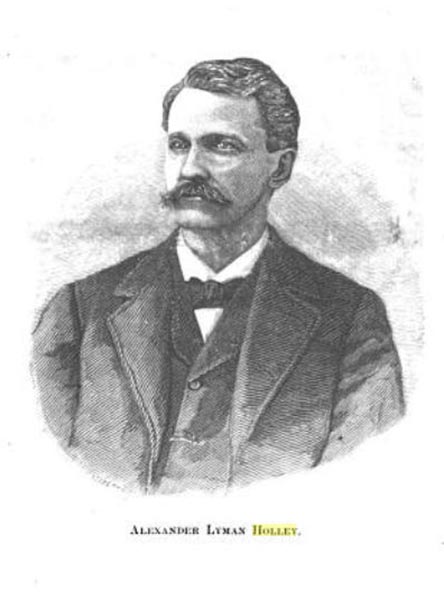Alexander Lyman Holley (July 30, 1832 - January 29, 1882) was an American mechanical engineer. Born in Lakeville, Connecticut, Holley entered Williams Academy in Stockbridge, Massachusetts, in 1848, and then attended Brown University, from which he graduated in 1853 where 'he took the regular degree of the scientific course'. Per the New York City Parks Department biography (a memorial to Holley stands in Washington Square Park) Holley was the first person to graduate from Brown in engineering, receiving a bachelor of philosophy. Holley went to work in the locomotive department of the works of G.H. Corliss and Nightingale (later the Corliss Steam Engine Works) as a workman and a student. He spent three years in Providence and took full advantage of his time there, learning everything his position offered to teach him. He left Corliss in 1857 to become a locomotive engineer on the Stonington and Providence Railroad, a job he held for a year. The following year (1858), Holley met Zerah Colburn, the founder of Railway Advocate and London Engineering, and Holley began writing professionally, alongside his work as a mechanic and draughtsman. Also in 1858, Holley joined the 'New York Locomotive Works' of Breese, Kneeland and Company in Jersey City, New Jersey. Per an obituary in the February 18, 1882, edition of American Machinist
While employed at Jersey City, he made the first colored and shaded drawing ever made in those works. It was of the locomotive 'America' and was noticeably finer than the lithographs subsequently made from it, eliciting the war admiration of every mechanic who saw it.Holley and Colburn went to Europe in 1859 (it is unclear if Holley had left the employ of the new York Locomotive Works at this point in time) as commissioners sent by the presidents of the leading American railroads to study the technical conditions of European railroads which produced 'The Permanent Way, and Coal-burning Locomotive Boilers of European Railways'. Holley also wrote for the New York Times in 1858 and 1859 and became a special correspondent for the Times in London in 1859. He returned to London once again in 1860 to cover the final construction phases and the maiden voyage of the Great Eastern (a huge side-wheel steamship). During the Atlantic crossing, Holley penned a letter to the times in which he predicted that screw propellers were soon supersede sidewheels. Holley was sent to Europe again in 1862, this time to study European ordnance and armor for Edwin A. Stevens, and subsequently published a book on the subject called 'Treatise on Ordnance and Armor'. During this trip to England Holley met Henry Bessemer (later Sir Henry Bessemer) who developed the Bessemer steel process. Holley learned the processed and upon returning to the United States obtained control of Bessemer's American patents. With this victory, secured in 1864, Holley became forever linked with Bessemer steel. This link pushed him to be involved in the establishment in one way or another of a series of steel works across the eastern United States. Holley also made improvements to the Bessemer process, including the resulting Holley vessel bottom, a modification that was used in all American works. He lectured at the Columbia College School of Mines and was a professor at Stevens College of Technology beginning in 1872. Holley was active in many professional engineering organizations and was President of the American Institute of Mining Engineers in 1875. He was in London with his family in the summer of 1881 when he became seriously ill for 'about ten weeks' and was finally ordered by his doctors to return to the United States. Unfortunately, he had to return without his wife and two adult daughters because one of his daughters was sick with typhoid fever. Upon reaching New York, his health did not improve, and he died 'only ten minutes before the arrival of his wife and children'.


